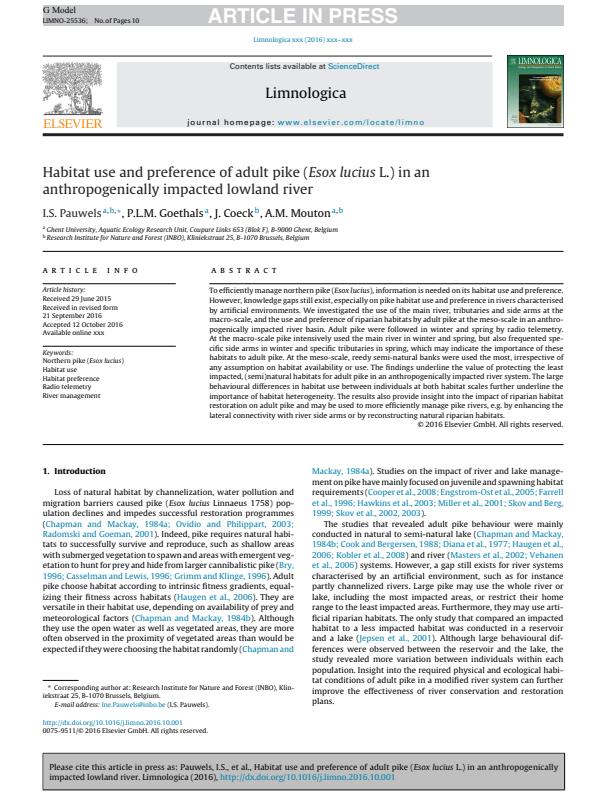Habitat use and preference of adult pike (Esox lucius L.) in an anthropogenically impacted lowland river
However, knowledge gaps still exist, especially on pike habitat use and preference in rivers characterised
by artificial environments. We investigated the use of the main river, tributaries and side arms at the
macro-scale, and the use and preference of riparian habitats by adult pike at the meso-scale in an anthropogenically
impacted river basin. Adult pike were followed in winter and spring by radio telemetry.
At the macro-scale pike intensively used the main river in winter and spring, but also frequented specific
side arms in winter and specific tributaries in spring, which may indicate the importance of these
habitats to adult pike. At the meso-scale, reedy semi-natural banks were used the most, irrespective of
any assumption on habitat availability or use. The findings underline the value of protecting the least
impacted, (semi)natural habitats for adult pike in an anthropogenically impacted river system. The large
behavioural differences in habitat use between individuals at both habitat scales further underline the
importance of habitat heterogeneity. The results also provide insight into the impact of riparian habitat
restoration on adult pike and may be used to more efficiently manage pike rivers, e.g. by enhancing the
lateral connectivity with river side arms or by reconstructing natural riparian habitats.
Details
| Aantal pagina's | 10 |
|---|---|
| Type | A1: Web of Science-artikel |
| Categorie | Onderzoek |
| Tijdschrift | Limnologica |
| Issns | 0075-9511 |
| Uitgeverij | Elsevier |
| Taal | Engels |
Bibtex
@misc{359fb8d3-ea73-4f84-b804-cf6d72b99d52,
title = "Habitat use and preference of adult pike (Esox lucius L.) in an anthropogenically impacted lowland river",
abstract = "To efficiently manage northern pike (Esox lucius), information is needed on its habitat use and preference.
However, knowledge gaps still exist, especially on pike habitat use and preference in rivers characterised
by artificial environments. We investigated the use of the main river, tributaries and side arms at the
macro-scale, and the use and preference of riparian habitats by adult pike at the meso-scale in an anthropogenically
impacted river basin. Adult pike were followed in winter and spring by radio telemetry.
At the macro-scale pike intensively used the main river in winter and spring, but also frequented specific
side arms in winter and specific tributaries in spring, which may indicate the importance of these
habitats to adult pike. At the meso-scale, reedy semi-natural banks were used the most, irrespective of
any assumption on habitat availability or use. The findings underline the value of protecting the least
impacted, (semi)natural habitats for adult pike in an anthropogenically impacted river system. The large
behavioural differences in habitat use between individuals at both habitat scales further underline the
importance of habitat heterogeneity. The results also provide insight into the impact of riparian habitat
restoration on adult pike and may be used to more efficiently manage pike rivers, e.g. by enhancing the
lateral connectivity with river side arms or by reconstructing natural riparian habitats.",
author = "Ine Pauwels and Peter Goethals and Johan Coeck and Ans Mouton",
year = "2016",
month = jan,
day = "01",
doi = "https://doi.org/10.1016/j.limno.2016.10.001",
language = "Nederlands",
publisher = "Elsevier",
address = "België,
type = "Other"
}

